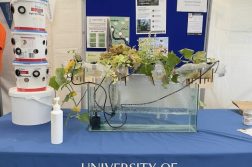Mars. You stand on the surface for 2 minutes and you’re dead. It is a radioactive, oxygen-deprived landscape of poisonous soil. So why bother colonising it when we have enough problems here on Earth? Well, human presence on a second planet would drastically decrease the likelihood of human extinction. Human observation could provide insight that robots would miss, and there could be valuable resources to be found. Also, living on Mars would be cool as fuck. So, how do we do it?
Let’s assume we’ve decided on a good location, and previous missions have built up a store of resources and equipment. First, the simple stuff. Water is easy to find since the poles are made of ice. Right, now on to the challenges.
Mars is further from the sun, so solar power is only 40% as effective, and the sun is often obscured by dust storms. Wind/geothermal energy is unusable as the atmosphere is 1% as dense as Earth’s and the interior is too cold. Combining solar and nuclear is best, using radioactive elements and a reactor from Earth, as Mars doesn’t have easily accessible uranium or thorium. Next, the living habitat needs to be pressurised and filled with nitrogen and oxygen to replicate Earth’s atmosphere. Pressurising means habitats must have rounded/smooth shapes.
Mars is lacking an extensive magnetosphere and dense atmosphere, so half of the radiation from space reaches the ground. This is a combination of galactic cosmic rays and solar energetic particles, both of which react with the soil and create secondary particles. We can get around this by shielding the habitats. As the atmosphere is mostly CO2 this can be harvested and frozen into thick layers around the habitats. Dirt could be placed on top of this for extra protection. This is an effective strategy unless you are a fan of living in a building with windows.
The lack of protection outside means that until the planet is terraformed (a short 100,000 year wait), residents will spend most of their time indoors, with remote-controlled robots completing work outside. But there’s a problem here too. Dust on Mars consists of very fine electrostatically charged particles, which stick to everything. It covers solar panels, decreasing their energy production, and it clogs up gears and gets into electronics. It was a dust storm that wrote the death certificate for the opportunity rover. These storms cover continent-sized areas and last for weeks.
Growing plants is a challenge as the soil is alkaline and lacking nitrogen. The soil would need decontaminating which is difficult and expensive. A better solution would be hydroponics: suspending plants in nutrient-rich water, removing the need for soil.
The gravity on Mars is only 38% as strong as on Earth, and will cause muscle & bone loss as well as heart problems. Mars dwellers will have to exercise a lot, and this will only slow the degradation. Also, the repetitive lifestyle, lack of time outside, and critically important work will be highly mentally strenuous. Time spent on Mars will probably not exceed 26 months (which is how often we have a narrow travel window) and during this time people will undergo regular psychological screenings.
And there we have it. Until better technologies allow us to overcome these problems, this ‘primitive’ setup would allow for human presence on the red planet for decades. All that is needed is a constant supply of crew members, resources, parts and nuclear fuel. Mars will be the toughest challenge we have ever faced. And look how well we’ve handled everything here! What could possibly go wrong….



